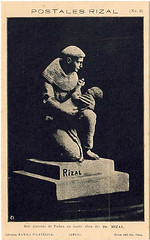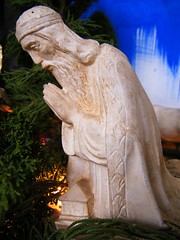I originally planned to post this entry to celebrate Jose Rizal's 150th birthday in July but never got around to doing so. Instead I'm posting it today on the 115th anniversary of his death.

Portrait of Jose Rizal by Fabian de la Rosa.
Author, Multilingualist, Doctor, Patriot and Martyr all describe the man who turns 150 years old today: Jose P. Rizal. Truly he is a man of many hats.
Though his novels and writings are what are best known today to Filipinos, Rizal is also an accomplished sculptor. From a young age he learned how to fashion figures out of clay and other materials-a skill he refined to a great degree as evident in his later works.
As a young student at Ateneo de Manila, Rizal created a devotional figure of the Sacred Heart at the request of one of his teachers. Carved out of wood, it shows a stiff Christ, exposing his heart-a rather crude santo.

Sagrado Corazon de Jesus.
Later, while in exile at Dapitan, he rendered the likeness of a local girl out of clay.
In this portrait, Rizal shows his great ability in understanding his subjects. He has perfectly captured the sitter's willful character with her piercing eyes and defined, strong brows. It is a life-like rendition, almost as if the subject is about to speak.

La Dapitana, 1890's.
Rizal's statues are often small and intimate, yet all posses a monumental quality in their symbolism.
In ¡Orate Frates! (Pray, Brother), Rizal's dislike for the corrupt frailes is evident in the way how he renders the Friar: corpulent and homely. Caricatural traits that have become synonymous with greed and lust.
Perhaps that is how he envisions Padre Damaso, the villain in his novel, Noli Me Tangere (Touch Me Not). It must be pointed out that Rizal's beef isn't mostly with Spain, but rather with the Catholic Church. He exposes the church's hypocritical nature and its exploitive, oppressive power over the archipelago through the characters of the monastic orders present in the story.

¡Orate Frates!
Everything that Rizal believed in and stood for can be found in Triumph of Science Over Death. In this small alabaster sculpture, he portrays Science as a victorious nude female. Science's stark nudity illustrates her purity and shameless pursuit of the Truth, a nuditas vitualis.
She tramples Death as she wields the Torch of Knowledge. With her guiding light, she frees mankind from the cold grips of ignorance and thereby from Death.
This sculpture is Rizal's statement that Filipinos no longer need to rely on blind faith in the divine or look to mystics when Science with all its facts and knowledge is there to guide them.
It is arguably his most famous sculpture. When I was a child, my mother would always point out the statue's replica to me whenever we were in UP.

Triumph of Science over Death.
Rizal created many sculptures throughout his life. Some have been lost to time or to the ravages of the Second World War though some of these sculptures can still be appreciated through photographs taken at the turn of the century.

San Antonio de Padua.

San Pablo Ermitaño, 1893.









